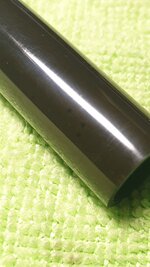bg15
Member
Hey guys,
I have been fiddling with Nikko ebonite for some time and I always get different results while finishing it. To be more exact - I cannot get ebonite to be pitch black and besides that, there are black spots visible under strong light.
My method of finishing is wet sanding from 320 - to 12000 micromesh + Buffing. I know ebonite hates the heat, that is why I use a lot of water when shaping it and sanding.
Have you ever seen this kind of spot on your ebonite?
I have been fiddling with Nikko ebonite for some time and I always get different results while finishing it. To be more exact - I cannot get ebonite to be pitch black and besides that, there are black spots visible under strong light.
My method of finishing is wet sanding from 320 - to 12000 micromesh + Buffing. I know ebonite hates the heat, that is why I use a lot of water when shaping it and sanding.
Have you ever seen this kind of spot on your ebonite?

